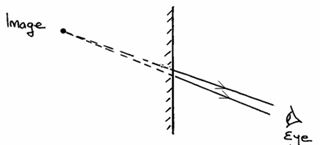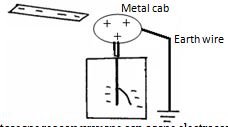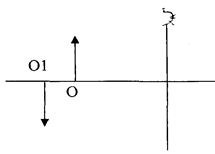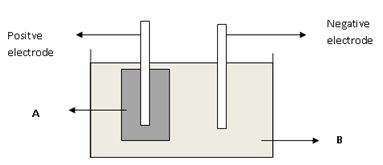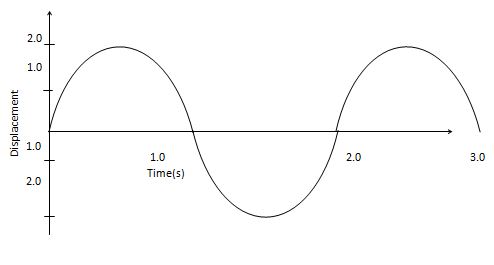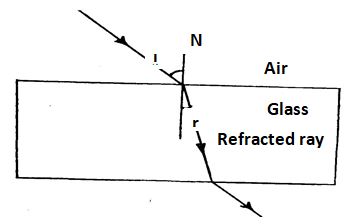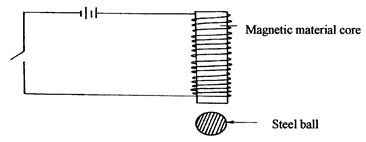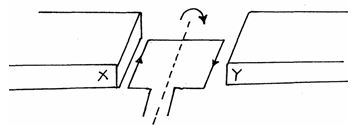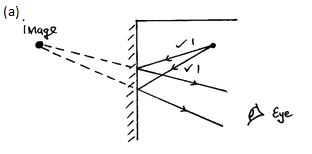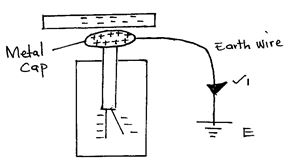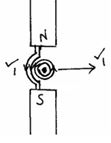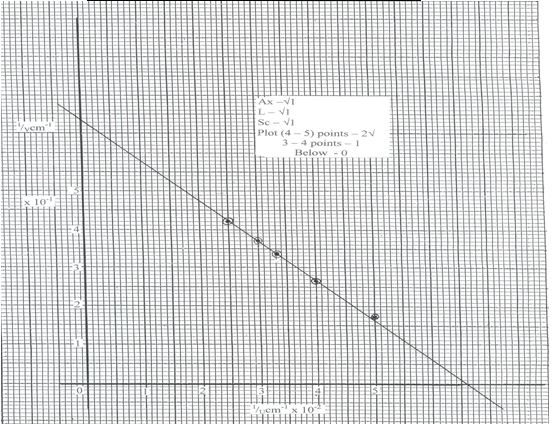SECTION A: (25 MARKS)
-
- Figure 1 shows an image formed in a plane mirror.
By drawing incident rays for the rays shown, locate the position of the object.(2 marks) - Explain how an enlarged hole in a pin hole camera produces a blurred image. (1mark)
- Figure 1 shows an image formed in a plane mirror.
- The figure 2 below shows an electroscope being charged by induction.
- State the reason why the cap of the electroscope is made circular.(1 mark)
- On the same diagram, show the direction of the flow of electrons on the earth wire.(1mk)
-
- the figure below shows a current carrying conductor placed perpendicularly between the poles of a magnet. Show on the diagram The direction of net force on the conductor. (1 mark)
- the figure below shows a current carrying conductor placed perpendicularly between the poles of a magnet. Show on the diagram The direction of net force on the conductor. (1 mark)
- Using domain theory, describe how a nail can be magnetised through hammering. (2marks)
- State two properties of an image formed by a concave mirror that makes it suitable for use by barbers. (2 marks)
- State two defects of a simple cell and how each can be corrected. (2 marks)
- An object is placed 20cm in front of a concave mirror of focal length 10cm and another identical object is place 20cm infront of a plane mirror
- Give one similarity of the image formed. (1mk)
- Give one difference between the image formed. (1mk)
- Figure 1 show a method used to charge conductors. The procedure follows steps a, b and c
Fig 1
- State the method of charging above. (1 mark)
- Explain what happens in step (b) above.(1 mark)
- The figure below shows the object O and its image O1 formed by a concave mirror
Locate theposition of the principle focus. (2marks) - A current of 0.8A flows through an electric circuit. Determine the quantity of charge that passes a point in the circuit in 6 minutes. (2 marks)
- A mine worker stands between two vertical cliffs 500m from the nearest cliff. The cliffs are xmetres apart. Every time he strikes the rocks, he hears the echoes. The first one comes after 2.5.s while the other comes 3s later. Calculate the distance between the cliffs. (3 mks)
- Figure below show a Leclanche cell
- Name the chemical substaces in the parts labeled (2mks)
A
B
- Name the chemical substaces in the parts labeled (2mks)
SECTION B:55 MARKS
- The figure below represents an oscillation taking place at a particular point when a sound wave in a gas passes the point. The vertical axis represents displacement.
- Explain what is meant by displacement in this context. (1 mark)
- From the graph, determine.
- Amplitude (1mk)
- Period (1mk)
- Frequency (2mks)
- Calculate the wavelength of the sound wave in the figure above. (Speed of sound in gas is 340m/s). (3 marks)
- State two factors that increases the speed of sound in solids.(2 marks)
- Distinguish between transverse and longitudinal waves. (2mks)
-
- A ray of light makes a glancing angle of incidence i=60 o with a flat glass surface as shown below
Given that the critical angle for glass is 42° determine;- The angle of refraction r
- Given that speed of light in air 3.0 x 10 8 m/s, find the speed of light in glass
- A microscope is focused on a mark on a horizontal surface. A rectangular glass block 30mm thick is placed on the mark. The microscope is then adjusted 10mm upwards to bring the mark back to focus. Determine the refractive index of the glass. (3mks)
- State the conditions to be satisfied for total internal reflection to occur. (2mks)
- A ray of light traveling in the direction EO in air enters a rectangular block at an angle of incidence 30° . The resulting angle of refraction is 18°
.
Find:-- The refractive index of the block. (2mks)
- The critical angle C of the block. (3mks)
- A ray of light makes a glancing angle of incidence i=60 o with a flat glass surface as shown below
-
-
- Define the term principal focus in relation to convex mirror (1mk)
- Distinguish between real and virtual image (2mks)
- The table below shows the object distance u, and the corresponding image distance V for an object placed infront of a concave mirror
U(cm) 20 25 30 35 40 45 V(cm) 60.0 37.5 30.0 26.3 24.0 22.5 1/ucm-1 1/vcm-1 - Complete the table (2mks)
- Plot a graph of I/V against 1/U (5mks)
- From the graph determine the focal length (2mks)
- Complete the table (2mks)
-
-
- The set up in figure 4 below can be used in a laboratory for lifting and releasing a steel ball.
- State the material which is suitable for use in the core. (1 mark)
- If a slightly larger ball is to be lifted, it is necessary to make an electromagnet stronger.Name two ways of increasing the strength of the magnet. (2 marks)
- Figure 4 shows a rectangular coil in a magnetic field rotating in a clockwise direction. The direction of induced current is as shown by the arrows.
- ndicate the poles X and Y of the magnets (2 mark)
X ____________________ Y ____________________ - Suggest one way of increasing the magnitude of the force in such a coil (1mark)
- ndicate the poles X and Y of the magnets (2 mark)
- What is meant by the term ‘direction of a magnetic field’ (1mk)
- State one property of magnets. (1mk)
- Repulsion is the surest test for polarity of a magnet. Explain (1mk)
- State the difference between magnetic properties of steel and soft iron(1mk)
- A steel bar was being magnetized by electrical method. It was noted that the strength of the magnet depended on the amount of current. The current was increased steadily until it was noted that the strength of the magnet could not increase further .Explain the observation (2mks)
- State two ways of demagnetizing a magnet (2mk)
- The set up in figure 4 below can be used in a laboratory for lifting and releasing a steel ball.
MARKING SCHEME
-
- It forms multiple images that overlap.
-
- For even distribution of charge.
- Nail is hammered in North - South direction.
Earth’s magnetic field aligns dipoles of the nail in one direction. - Produces an - Upright image.
Magnified image - Polarization – using a depolarizer e.g. potassium dichromate.
Local action – pure zinc/amalgamation -
- Same size as the image
Same distance from the mirror as the object. -
- Concave mirror
inverted
Real - Plane mirrior
Upright
Vitual
- Concave mirror
- Same size as the image
-
- Induction method
- Earthing to neutralise positive charges
- Q = It
= 0.8 x 6 x 60C
∴Q = 288C - V = 2d/t
⇒500 x 2/2.5 = 2(x – 500)mk
= 1600 M - A: mixture of carbon and manganese IV oxide
B: ammonium chloride solution/jelly
SECTION B
-
-
- Maximum distance from rest position.or Maximum distance from mean position.
-
- amplitude=2
- T=2s
- f=1/t =1/2=0.5
V = ƒλ
340 = 0.5×λ
λ = 340/0.5 - High density.
Low temperature. - Transverse waves-particle vibration of particles is perpendicular to direction of wave travel
Longitudinal waves-particle vibration of particles is parallel to direction of wave travel
-
-
- η =1/sinC=1/sin42 =1.4945
1.4945=sin60/sinr
r = 35.42 o - η = (velocity in air)/(velocity in glass)
1.4945= 3x108/velocity in glass
Velocity in glass= 2.0074 x 108m/s
- η =1/sinC=1/sin42 =1.4945
- η = (r.d)/(a.d)
η =30/20=1.5 - Light must travel from denser medium to less dense medium.
Angle of incidence in the denser medium must be greater than critical angle in the less dense medium. -
- sin i/sin r = n
sin 30°/sin 180° = 1.618
n = 1.618 - sin C = 1/n
sin C = 1/1.618
C = sin-1 0.61804
C = 38.17°
- sin i/sin r = n
-
- A point on the principal axis at which rays parallel and close to the principal axis appear to diverge after reflection.
- A real image is formed when real rays of light meet but a virtual image is formed when rays of light appear to meet but do not actually meet.
U(cm) 20 25 30 35 40 45 V(cm) 60.0 37.5 30.0 26.3 24.0 22.5 1/ucm-1 0.05 0.04 0.033 0.029 0.025 0,022 1/vcm-1 0.017 0,027 0.033 0.038 0.042 0044 - X &Y – intercepts = 6.6 ± 0.1cm-1
I/f =I/U +I/vwhen I/u=0
then I/f=I/u I/f =1/ 6.6 x 10-2
= 15.15cm
Focal length = 1515(15.0–1516)
-
- Soft iron since it is easily magnetized and demagnetized.
- Increasing the amount of current
Increasing the number of turns on the coil
- X:……..SOUTH Y:…….NORTH
- The direction which a free North pole would move if placed at that point in the magnetic field;
- Directional property
Magnetic poles - Repulsion occurs only for like poles-Attraction occurs for both unlike poles ,and poles of a magnet and a magnetic material.
- Steel is a material that takes long to be magnetized and retains its magnetism for equally a long time while soft Iron are easily magnetized and at the same , they lose their magnetism easily
- Because as the current flowed through the steel bar the domains were being aligned in the same direction√1 hence magnetizing the steel bar. The strength of the magnet could not, Increases further since all the domains were aligned in the same direction hence magnetically saturated
-
- By hammering the magnet in an east –west direction
- By heating and cooling the magnet
Join our whatsapp group for latest updates
Tap Here to Download for 50/-
Get on WhatsApp for 50/-
Download PHYSICS Paper 2 Questions and Answers - Form 3 End Term 1 Exams 2023.
Tap Here to Download for 50/-
Get on WhatsApp for 50/-
Why download?
- ✔ To read offline at any time.
- ✔ To Print at your convenience
- ✔ Share Easily with Friends / Students

